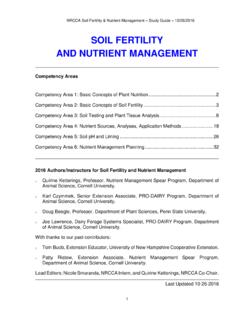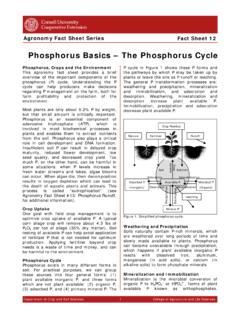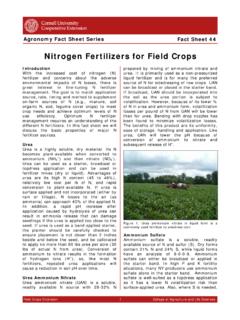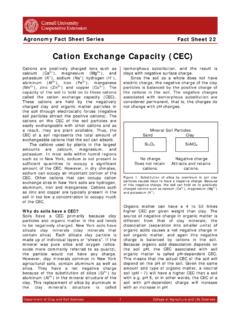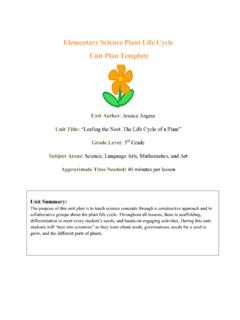Transcription of Nitrogen Basics – The Nitrogen Cycle - Cornell University
1 Fact Sheet 2 Nitrogen Basics The Nitrogen Cycle Agronomy Fact Sheet Series Department of Crop and Soil Sciences 1 College of Agriculture and Life Sciences Nitrogen , Crops and the Environment Nitrogen (N) is essential for the development of field crops. When N is deficient, root systems and plant growth are stunted, older leaves turn yellow and the crop is low in crude protein. Too much N can delay maturity and cause excessive vegetative growth at the expense of grain yield. Nitrogen fertilizer is expensive and losses can be detrimental to the environment.
2 Efficient use of N by meeting crop needs while avoiding excessive applications of N is an important goal. This fact sheet provides a brief overview of the important components of the N Cycle to aid in reaching that goal. Nitrogen Cycle The N Cycle illustrates how N from manure, fertilizers and plants moves through the soil to crops, water and the air. Understanding the N Cycle will help you make the best use of manure and fertilizers to meet crop needs while safeguarding the environment.
3 In general, the N Cycle processes of fixation, mineralization and nitrification increase plant available N. Denitrification, volatilization, immobilization, and leaching result in permanent or temporary N losses from the root zone. Read on for specifics about each of the N Cycle processes. Fixation refers to the conversion of atmospheric N to a plant available form. This occurs either through an industrial process, as in the production of commercial fertilizers, or a biological process, as with legumes such as alfalfa and clover.
4 Nitrogen fixation requires energy, enzymes and minerals, so if a plant available form of N is present, the crop will use it instead of fixing it from the air. When legumes are tilled into the soil, the N stored in their roots is released and made available to the next crop or lost to the environment, depending on management. In mixed legume-grass stands, the grass can utilize N fixed by the legumes. If the stand has 25% or more legume, no additional N is needed. Mineralization is the process by which microbes decompose organic N from manure, organic matter and crop residues to ammonium.
5 Because it is a biological process, rates of mineralization vary with soil temperature, moisture and the amount of oxygen in the soil (aeration). Mineralization readily occurs in warm (68-95 F), well-aerated and moist soils. In New York State, approximately 60 80 lbs of N per acre is mineralized on average from soil organic matter each year. Nitrification is the process by which microorganisms convert ammonium to nitrate to obtain energy. Nitrate is the most plant available form of N, but is also highly susceptible to leaching losses.
6 Nitrification is most rapid when soil is warm (67-86 F), moist and well-aerated, but is virtually halted below 41 F and above 122 F. R-NH2 NH3 NH4+ organic N ammonia ammonium N2 NH3 R-NH2 Nitrogen gas ammonia organic N NH4+ NO2- NO3- ammonium nitrite nitrate The Nitrogen Cycle Department of Crop and Soil Sciences 2 College of Agriculture and Life Sciences Denitrification occurs when N is lost through the conversion of nitrate to gaseous forms of N, such as nitric oxide.
7 Nitrous oxide and dinitrogen gas. This occurs when the soil is saturated and the bacteria use nitrate as an oxygen source. De-nitrification is common in poorly drained soils. Volatilization is the loss of N through the conversion of ammonium to ammonia gas, which is released to the atmosphere. The volatilization losses increase at higher soil pH and conditions that favor evaporation ( hot and windy). Volatilization losses are higher for manures and urea fertilizers that are surface applied and not incorporated (by tillage or by rain) into the soil.
8 Manure contains N in two primary forms: ammonium and organic N. If manure is incorporated within one day, 65% of the ammonium N is retained; when incorporated after 5 days the ammonium N will have been lost through volatilization. Organic N in manure is not lost through volatilization, but it takes time to mineralize and become plant available. Immobilization is the reverse of mineralization. All living things require N; therefore microorganisms in the soil compete with crops for N.
9 Immobilization refers to the process in which nitrate and ammonium are taken up by soil organisms and therefore become unavailable to crops. Incorporation of materials with a high carbon to Nitrogen ratio ( sawdust, straw, etc.), will increase biological activity and cause a greater demand for N, and thus result in N immobilization Immobilization only temporarily locks up N. When the microorganisms die, the organic N contained in their cells is converted by mineralization and nitrification to plant available nitrate.
10 Leaching is a pathway of N loss of a high concern to water quality. Soil particles do not retain nitrate very well because both are negatively charged. As a result, nitrate easily moves with water in the soil. The rate of leaching depends on soil drainage, rainfall, amount of nitrate present in the soil, and crop uptake. The EPA has set the maximum contaminant level for drinking water at 10 ppm N as nitrate. Well-drained soils, unexpected low crop yield, high N inputs (especially outside of the growing season) and high rainfall are all conditions that increase the potential for nitrate leaching.

